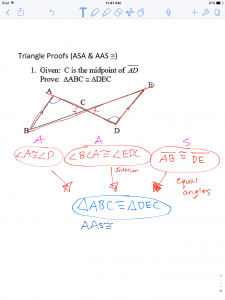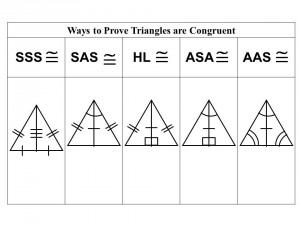Blog 25: AAS and ASA
In this lesson, we learned two congruence conditions to prove that a pair of triangles are congruent. When two triangles are congruent, they could be the same side. The two conditions that we learned are “AAS ” congruence or angle angle side and “ASA” congruence or angle side angle. These conditions mean that in order for a pair of triangles to be congruent, their angles and sides must be congruent. In order to prove that they are congruent, you need at least three pieces of information. To have triangles congruent to each other, you need at least 2 equal angles and 1 equal length. There could be two angles next to each other then a side, or an angle then a side than an angle.
Blog 26: Using Flocharts
Today, we learned how to set up flowcharts to prove a pair of triangles are congruent. Flowcharts, are various ovals in which you provide the information that you know or have gathered to prove a pair of triangles are congruent. Usually, a flowchart would have the given information in the top ovals. The “given” information is what they are telling you about the pair of triangles using parallel or congruent symbols that are drawn on the triangles. On the second row, you would usually have the information that you know based on what was given to you. On the bottom of each oval, you would write how you know this information. For example, you would put in an oval that line segment AB is congruent to line segment BA and under that oval you would write reflexive property. We were given a sheet that showed various properties, definitions and theorems for triangles that you can use to write under your ovals how you know they are congruent (examples in blue below).
Blog 27: Triangle Congruence Conditions
There are five different triangle congruence conditions that we learned today. Triangle congruence conditions help determine if triangles are congruent. They have three letters that mean angles or sides. The conditions are ASA or angle side angle, SAS or side angle side, SSS or side side side, AAS and HL which is hypotenuse leg. For hypotenuse leg, this condition can only be used with right triangles. The letters must be in order as they are in the triangle. For example, there has to be an angle next to side then another angle. In other words, you cannot just write the letters in a random order. There are three conditions that cannot be used, these are side side angle , angle side side or three angles. You cannot use three angles because the angles might be the same but not the length of the sides, therefore making the triangles not congruent.
Blog 28: Determining a Midpoint
Today in class, we learned various methods to help us determine the midpoint of a line segment. The first thing you have to do is find both the coordinates of the line segment. For example, (-1,2) (3,16). To find the point exactly halfway between two given points, I average the x-values and the y-values. (Example below) I would need to add the x values and put them over two as well for the y values. Then, you are left with two fractions which you then simplify to create your coordinates for your midpoint.








Leave a Reply